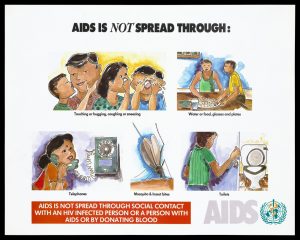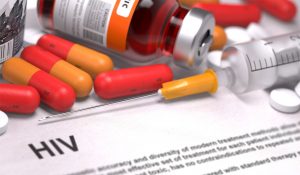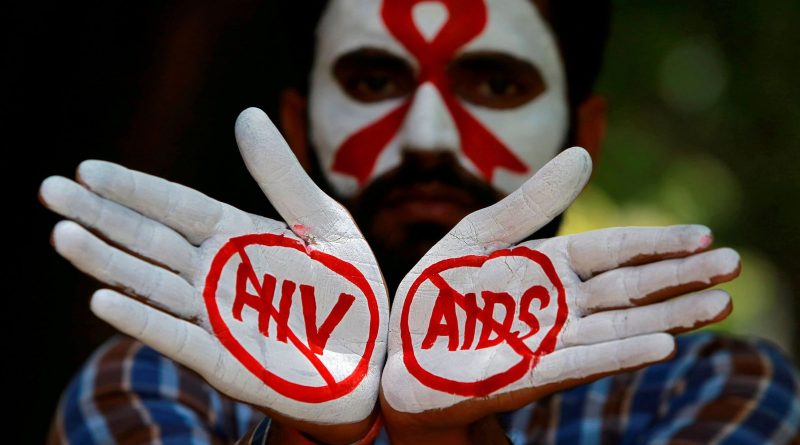Beyond Myths & Misconceptions

If you are diagnosed with HIV, don’t think your existence is doomed. With adequate awareness, safeguards and counseling, you can manage to lead a long, happy and fulfilling life….
By Dr Suneela Garg
There are a lot of misconceptions about what it means to be living with HIV. Ultimately, everyone’s life is different. How you cope with your diagnosis and how you move forward will be unique.
But remember, HIV doesn’t stop you living a long, happy and fulfilling life. With the right treatment and support, it is possible to live as long as the average person. No doubt learning that you are HIV positive can be one of the most difficult experiences you go through in your life. You may feel scared, sad or even angry. This is understandable and a completely natural part of coping with something that can be life changing.
Today millions of people have HIV, you are definitely not alone. Most people get at least one STD in their lifetime, and having HIV or another STD is nothing to feel ashamed of or embarrassed about. It does not mean you are dirty or a bad person.
Finding out that you have HIV can be really upsetting. You might feel mad, embarrassed, scared, or ashamed at first. But you’ll probably feel better as time goes by. Having a good support system and getting counseling really helps. There are medicines you can take to help you stay healthy, and lots of ways to avoid giving HIV to anyone you have sex with. The reality is, people with HIV can be in relationships, have sex, and live normal lives by taking a few precautions.
Although there is no cure for HIV, there are medicines that help people with HIV live longer, healthier lives. HIV treatment called antiretroviral therapy (ART) lowers the amount of virus in your body (called your viral load). This does two things first slows down the effects of HIV in your body, which keeps you healthy and second lowers or even stops your chances of giving HIV to sexual partners.
Some people on ART have such a small amount of virus in their body; they cannot transmit HIV to their sexual partners at all. Even if you are feeling totally fine right now, see a doctor as soon as you can so you can talk about the best ways to stay healthy.
Taking care of emotional health is very important. It is a good idea to see a counselor or therapist who is trained to help people with HIV. There are a lot of online and in-person support groups that can give you a safe place to talk about your feelings with people who understand what you’re going through.
It might feel scary to admit that one has HIV, but talking about things can really ease your mind. You could lean on a close, non-judgmental friend or family member whom you trust to keep the conversation private. Counselors and support groups can also be sources of comfort and they can help you figure out how to talk with others about your HIV. Be careful about who you tell your status as people with HIV sometimes deal with unfair discrimination.
Acquired immunodeficiency syndrome (AIDS) is a chronic, potentially life-threatening condition caused by the human immunodeficiency virus (HIV). By damaging your immune system, HIV interferes with your body’s ability to fight the organisms that cause disease.
HIV is a sexually transmitted infection (STI) which can also be spread by contact with infected blood or from mother to child during pregnancy, childbirth or breast-feeding. Without medication, it may take years before HIV weakens your immune system to the point that you have AIDS.
There is no cure for HIV/AIDS, but there are medications that can dramatically slow the progression of the disease. These drugs have reduced AIDS deaths in many developed nations.
The symptoms of HIV and AIDS vary, depending on the phase of infection. Most people infected by HIV develop a flu-like illness within a month or two after the virus enters the body. This illness, known as primary or acute HIV infection, may last for a few weeks. As the virus continues to multiply and destroy your immune cells — the cells in your body that help fight off germs — you may develop mild infections or chronic signs and symptoms such as fever, fatigue, swollen lymph nodes often one of the first signs of HIV infection, diarrhea, weight loss, oral yeast infection (thrush) and shingles (herpes zoster)
When AIDS occurs, your immune system has been severely damaged. You’ll be more likely to develop opportunistic infections or opportunistic cancers, diseases that would not usually trouble a person with a healthy immune system.
The signs and symptoms of some of these infections may include soaking night sweats securing fever, chronic diarrhea, persistent white spots or unusual lesions on your tongue or in the mouth, persistent, unexplained fatigue, weight loss and skin rashes or bumps. HIV is caused by a virus. It can spread through sexual contact or blood, or from mother to child during pregnancy, childbirth or breast-feeding.
These symptoms can be so mild that you might not even notice them. However, the amount of virus in your bloodstream (viral load) is quite high at this time. As a result, the infection spreads more easily during primary infection than during the next stage.
Clinical latent infection (Chronic HIV)
In some people, persistent swelling of lymph nodes occurs during this stage. Otherwise, there are no specific signs and symptoms. HIV remains in the body and in infected white blood cells.
This stage of HIV infection generally lasts around 10 years if you’re not receiving antiretroviral therapy. But sometimes, even with this treatment, it lasts for decades. Some people develop more severe disease much sooner.
 How does HIV become AIDS?
How does HIV become AIDS?
HIV destroys CD4 T cells — white blood cells that play a large role in helping your body fight disease. The fewer CD4 T cells you have, the weaker your immune system becomes. You can have an HIV infection for years before it turns into AIDS. AIDS is diagnosed when the CD4 T cell count falls below 200 or you have an AIDS-defining complication. To become infected with HIV, infected blood, semen or vaginal secretions must enter your body. This can happen in several ways:
You may become infected if you have vaginal, anal or oral sex with an infected partner whose blood, semen or vaginal secretions enter your body. The virus can enter your body through mouth sores or small tears that sometimes develop in the rectum or vagina during sexual activity.
In some cases, the virus may be transmitted through blood transfusions. Hospitals and blood banks now screen the blood supply for HIV antibodies, so this risk is very small. Sharing contaminated intravenous drug paraphernalia (needles and syringes) puts you at high risk of HIV and other infectious diseases, such as hepatitis. Infected mothers can pass the virus on to their babies. HIV-positive mothers who get treatment for the infection during pregnancy can significantly lower the risk to their babies.
How HIV does not spread
You cannot become infected with HIV through ordinary contact. That means you can’t catch HIV or AIDS by hugging, kissing, dancing or shaking hands with someone who has the infection. HIV is not spread through the air, water or insect bites.
Risk factors
When HIV/AIDS first appeared in the United States, it mainly affected men who had sex with men. However, now it’s clear that HIV also spreads through heterosexual sex. Anyone of any age, race, sex or sexual orientation can be infected. However, you’re at greatest risk of HIV/AIDS if you have unprotected sex. Always use a new latex or polyurethane condom every time while you have sex. Anal sex is more risky than is vaginal sex. If you have multiple sexual partners then there is always risk of HIV increase.
Many STIs produce open sores on your genitals. These sores act as doorways for HIV to enter your body. People who use intravenous drugs often share needles and syringes. This exposes them to droplets of other people’s blood. Studies suggest that lack of circumcision increases the risk of heterosexual transmission of HIV. HIV infection weakens your immune system, making you much more likely to develop numerous infections and certain types of cancers.
Infections common to HIV/AIDS
In resource-limited nations, TB is the most common opportunistic infection associated with HIV. It’s a leading cause of death among people with AIDS. Cytomegalovirus is common herpes virus which is transmitted in body fluids such as saliva, blood, urine, semen and breast milk. A healthy immune system inactivates the virus, and it remains dormant in your body. If your immune system weakens, the virus resurfaces causing damage to your eyes, digestive tract, lungs or other organs. Candidiasis is a common HIV-related infection. It causes inflammation and a thick, white coating on the mucous membranes of your mouth, tongue, esophagus or vagina.
Meningitis is an inflammation of the membranes and fluid surrounding your brain and spinal cord (meninges). Cryptococcal meningitis is a common central nervous system infection associated with HIV, caused by a fungus found in soil. Toxoplasmosis is potentially deadly infection which is caused by Toxoplasma gondii, a parasite spread primarily by cats. Infected cats pass the parasites in their stools, which may then spread to other animals and humans. Seizures occur when it spreads to the brain.
Cancers common to HIV/AIDS
A tumor of the blood vessel walls, Kaposi’s sarcoma is rare in people not infected with HIV, but common in HIV-positive people. It usually appears as pink, red or purple lesions on the skin and mouth. In people with darker skin, the lesions may look dark brown or black. Kaposi’s sarcoma can also affect the internal organs, including the digestive tract and lungs. Lymphoma cancer starts in the white blood cells. The most common early sign is painless swelling of the lymph nodes in the neck, armpit or groin.
There’s no vaccine to prevent HIV infection and no cure for AIDS. But you can protect yourself and others from infection.
To help prevent the spread of HIV
Use a new condom every time you have anal or vaginal sex. Women can use a female condom. If using a lubricant, make sure it is water-based. Oil-based lubricants can weaken condoms and cause them to break. During oral sex use a non lubricated, cut-open condom or a dental dam a piece of medical-grade latex.
Consider pre exposure prophylaxis. The combination drugs emtricitabine plus tenofovir (Truvada) and emtricitabine plus tenofovir alafenamide (Descovy) can reduce the risk of sexually transmitted HIV infection in people at very high risk.
Mostly the doctor prescribes these drugs for HIV prevention only if one does not already have HIV infection. You will need an HIV test before you start taking PrEP and then every three months as long as you’re taking it. Your doctor will also test your kidney function before prescribing Truvada and continue to test it every six months. One needs to take the drugs every day. They don’t prevent other STIs, so you’ll still need to practice safe sex. If you have hepatitis B, you should be evaluated by an infectious disease or liver specialist before beginning therapy.
It is very important to tell all your current and past sexual partners that you’re HIV-positive. They’ll need to be tested. If you use a needle to inject drugs, make sure it’s sterile and don’t share it. Take advantage of needle-exchange programs in your community and consider seeking help for your drug use.
If you are pregnant, get medical care right away. If you are HIV-positive, you may pass the infection to your baby. But if you receive treatment during pregnancy, you can cut your baby’s risk significantly. There is evidence that male circumcision can help reduce the risk of getting HIV infection.

AIIDS in India
The government of India estimates that about 2.40 million Indians are living with HIV (1.93 – 3.04 million) with an adult prevalence of 0.31% (2009). Children (<15 yrs) account for 3.5% of all infections, while 83% are the in age group 15-49 years. Of all HIV infections, 39% (930,000) are among women. India’s highly heterogeneous epidemic is largely concentrated in only a few states — in the industrialized south and west, and in the north-east. The four high prevalence states of South India (Andhra Pradesh – 500,000, Maharashtra – 420,000, Karnataka – 250,000, Tamil Nadu – 150,000) account for 55% of all HIV infections in the country. West Bengal, Gujarat, Bihar and Uttar Pradesh are estimated to have more than 100,000 PLHA each and together account for another 22% of HIV infections in India.
The Indian epidemic is concentrated among vulnerable populations at high risk for HIV. The concentrated epidemics are driven by unprotected sex between sex workers and their clients and by injecting drug use with contaminated injecting equipment. Several of the most at risk groups have high and still rising HIV prevalence rates. According to India’s National AIDS Control Organization (NACO), the bulk of HIV infections in India occur during unprotected heterosexual intercourse. Consequently, and as the epidemic has matured, women account for a growing proportion of people living with HIV, especially in rural areas. The low rate of multiple partner concurrent sexual relationships among the wider community seems to have, so far, protected the larger body of people. However, although overall prevalence remains low, even relatively minor increases in HIV infection rates in a country of more than one billion people translate into large numbers of people becoming infected.
The World Health Organization (WHO) has issued new recommendations to help countries reach the 8.1 million people living with HIV who are yet to be diagnosed, and who are therefore unable to obtain lifesaving treatment.
WHO is encouraging all countries to adopt a standard HIV testing strategy which uses three consecutive reactive tests to provide an HIV positive diagnosis. Previously, most high burden countries were using two consecutive tests. The new approach can help countries achieve maximum accuracy in HIV testing.
WHO recommends countries use HIV self-testing as a gateway to diagnosis based on new evidence that people who are at higher HIV risk and not testing in clinical settings are more likely to be tested if they can access HIV self-tests.
WHO also recommends social network-based HIV testing to reach key populations, who are at high risk but have less access to services. These include MSM, people who inject drugs, CSW, transgender population and people in prisons. These “key populations” and their partners account for over 50% of new HIV infections. For example, when testing 99 contacts from social networks of 143 HIV-positive people in the Democratic Republic of Congo, 48% tested positive for HIV.
The use of peer-led, innovative digital communications such as short messages and videos can build demand- and increase uptake of HIV testing. Evidence from Vietnam shows that online outreach workers counselled around 6 500 people from at-risk key population groups, of which 80% were referred to HIV testing and 95% took the tests. The majority (75%) of people who received counselling had never been in contact before with peer or outreach services for HIV.
WHO recommends focused community efforts to deliver rapid testing through lay providers for relevant countries in the European, South-East Asian, Western Pacific and Eastern Mediterranean regions where longstanding laboratory-based method called “western blotting” is still in use. Evidence from Kyrgyzstan shows that HIV diagnosis which took 4-6 weeks with the “western blotting” method now takes only 1-2 weeks and is much more affordable resulting from policy change.
Using HIV/syphilis dual rapid tests in antenatal care as the first HIV test can help countries eliminate mother-to-child transmission of both infections. More integrated approaches for HIV, syphilis and hepatitis B testing is also encouraged.
(The author is Director Professor HAG & Ex Head Community Medicine, Maulana Azad Medical College and Associated Hospitals, New Delhi)

